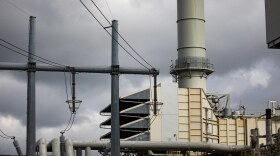Editor's note: Since the publication of this story, new information has come to light suggesting that longstanding problems on a transmission line bringing power from South Texas also played a role in Wednesday's grid emergency. Read more here.
Over a summer of record-breaking heat and energy use, the Electric Reliability Council of Texas has frequently called on Texans to voluntarily conserve power to help shore up the grid. But on Wednesday night, ERCOT went much further, entering into emergency operations for the first time since 2021 and introducing the possibility that rolling blackouts may be necessary to stabilize the Texas power system.
The evening started, as many before it, with a conservation call. Starting around 6 p.m., ERCOT asked people to voluntarily keep their air conditioning turned down and not run big appliances. The call came, the group said, as heat drove energy demand up and wind power was forecasted to be low.
These calls for conservation are one option the grid operator has to help balance energy supply and demand on the grid. When supply and demand are out of whack, it disrupts the frequency over which electricity travels on the system. The frequency should be kept steady at about 60 hertz. If it deviates for too long, that can break the electric grid, leading to catastrophe.
Despite that call to conserve, between 6:30 p.m. and 7 p.m., the power reserves available to the Texas grid began dropping suddenly. A drop in reserves is common in the evenings, as solar power decreases as the sun goes down. But the speed at which the system lost energy suggests more was at play, prompting some grid-watchers to suspect a large power plant stopped working.
Regardless of the cause, the shock to the system appears to have caught grid operators off guard.
When energy reserves start to look threatened, ERCOT will ideally call an Emergency Alert Level 1, allowing it to pull power resources from new places to stabilize the grid. In this case, the grid operator immediately declared an Alert Level 2 at around 7:30 p.m.
That’s the level just preceding rolling blackouts.
“Controlled outages may be needed to protect the electric system,” the group warned in an email. “Please reduce electric use. If you have medical needs, contact your local utility, and have a backup plan."
Around the same time, the frequency of the grid also started to tumble.
Declaring an energy Emergency Alert Level 2 allowed ERCOT to take several actions to rebalance the grid, including enacting more demand response programs that pay large power users to conserve energy, forcing any idling power generators (if, indeed, any were idling) to produce electrons, and trying to pull extra electricity from the few interconnections between Texas' grid and neighboring grids. Texas is the only state with its own independent power grid.
“Tonight, in ERCOT there was a sudden frequency drop, for reasons that are still being investigated. Industrial loads were called upon to shut down their operations and help stabilize the grid,” read a statement from the Texas Association of Manufacturers. “Many reduced their usage voluntarily, while others were retained by ERCOT in advance to address this type of unexpected situation.”
Some of these tactics have proven controversial with consumers. One program that pays big power users like cryptocurrency operations millions to conserve, has come under particular scrutiny, as Texans have been asked to conserve voluntarily for months.
If these emergency tactics don’t stabilize the grid, the next option is "rolling blackouts," meaning to cut power to users for brief periods of times to rebalance supply and demand.
On Wednesday night, that last resort was not needed.
The emergency lasted about two hours, after which ERCOT said grid conditions had returned to normal.
“By entering EEA 2, ERCOT was able to utilize additional reserve resources to protect the reliability of the grid,” the grid operator said around 9:30 p.m. “No power outages associated with the ERCOT power grid were necessary.”
The event left unanswered questions, especially about what happened to energy supply. People are wondering why reserves dropped so quickly, and why the grid operator appeared to not see it coming.
But the one other, obvious, contributing factor was record-high energy demand due to a Texas heat wave that has begun to feel never-ending.
"This is what happens when it is 97 degrees outside at ~8 pm," Michael Webber, a professor in UT Austin’s Department of Mechanical Engineering tweeted. "Demand at 8 pm this year is as high as our 5 pm peaks last year. Insane."
This is a developing story …















